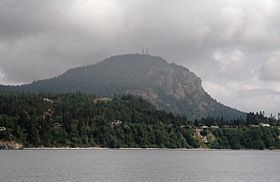Mount Erie (Washington)
| Mount Erie | |
|---|---|

Mount Erie from Burrows Bay
|
|
| Highest point | |
| Elevation | 1,273 ft (388 m) NAVD 88 |
| Prominence | 1,273 ft (388 m) |
| Coordinates | 48°27′14″N 122°37′33″W / 48.453791292°N 122.625708886°WCoordinates: 48°27′14″N 122°37′33″W / 48.453791292°N 122.625708886°W |
| Geography | |
| Location | Skagit County, Washington, U.S. |
| Climbing | |
| Easiest route | Paved Road |
Mount Erie is a mountain in Skagit County, Washington. The park land is owned and operated by the city of Anacortes and is located in the south of the Anacortes Community Forest Lands.
Mount Erie was named in 1841 by the Wilkes Expedition for the Battle of Lake Erie.
The mountain itself was first explored in the 1960s by local climbers, including Dallas Kloke. The mountain is known for its climbing as well as the view from the summit. Mount Erie is a city park operated by the City of Anacortes and the summit is accessible via a single-lane, paved road from the base. At 1,273 feet (388 meters) tall, Mount Erie is the highest point on Fidalgo Island. Mount Baker, which lies about 43 miles to the northeast, can easily be seen from Mount Erie. On a clear day, Mount Rainier can be seen in the southeast, approximately 117 miles distant.
The mountain is composed mostly of feldspar and hornblende rich diorite.
The band Mount Eerie, known as The Microphones before 2004, is named after this northwestern location. Principal member singer/songwriter Phil Elverum grew up in the area.
Located near the Fidalgo Complex in the San Juan Islands of Washington Mt. Erie has a unique and somewhat puzzling composition. Mt. Erie is thought to have been formed during the Jurassic period (155-170 Ma.) by invasive volcanic flows creating batholithic masses of diorite, which also helped to create the island arcs associated with the San Juan Islands. By the end of the late Jurassic period the area experienced uplift and erosion and was subjected to intense folding and faulting. At this point most of the deposited Paleozoic and Mesozoic sediments had been eroded away exposing the plutons of diorite, which is the primary igneous rock found on Mt Erie.
At some point the diorite pluton experienced intrusion by gabbro dikes associated with the formation of oceanic seafloor, indicating that the area may have experienced periods of submersion as the Juan de Fuca plate subducted underneath the North American plate accreted the area. This whole process of constant uplift and erosion followed by accretion is thought to have created the unique ophiolites associated with the San Juan Islands and primarily the Fidalgo Complex located near the mountain.
...
Wikipedia
